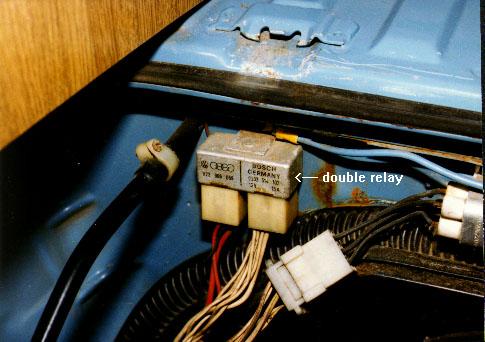Double Relay
The double relay is mounted to the firewall of the engine compartment on Buses and Vanagons. It is a silver box with two large white plastic connector plugs to it.

Here is a good description of how the double relay works, provided by the Bentley manual:
1) When the starter is operated, current from terminal 50 on the starter solenoid supplies positive (+) current to terminal 86a of the double relay, causing one of the relays -- the fuel pump relay -- to close and send battery voltage from terminal 30 on the starter to the electric fuel pump, via double relay terminals 88y and 88d.
2) Because the ignition is turned on when the starter is operating, ignition primary terminal 15 delivers positive (+) current to double relay terminal 86c, thereby closing the power relay that sends positive (+) current from the battery to all electrical parts of the fuel injection system with the exception of the fuel pump, the cold start valve, and the auxiliary air regulator -- which, except for the cold start valve, receive positive (+) current from the pump relay. The power relay remains closed as long as the ignition is on and will not open again until the ignition is turned off.
3) When the engine has started, the driver moves the key from the start (3) position to the running (2) position. This removes the supply of positive (+) current that was reaching double relay terminal 86a from terminal 50 of the starter -- the current that had originally closed the pump relay. However, the pump relay now receives current from the pump switch in the intake air sensor, via terminal 86b and the resistor of the double relay. Whether or not the pump operates depends on whether or not the pump switch in the intake air sensor opens or closes the pump relay.
4) When the driver stops the engine by turning off the ignition, ignition current no longer reaches double relay terminal 86c. The power relay opens, breaking all positive (+) connections between the fuel injection system and the car's electrical system.
The double relay can be tested electrically to make sure the two relays are opening and closing like they are supposed to.
Here is the test procedure for the double relay:
To Test Current Supply:
1) Detach the double relay from the tank compartment panel. Connect one test probe of a test lamp to terminal 85 of the double relay (which is grounded to the negative post of the battery).
2) Apply the second test probe to terminal 88y. Repeat the test by applying the second test probe to terminal 88z. The test lamp should light during both repetitions of the test. If not, positive (+) battery current is not reaching the terminal to which the second probe is connected.
3) With the ignition turned to the running (2) position, apply the second test probe to terminal 86c. If the test lamp fails to light, positive (+) battery current is not reaching terminal 86c from terminal 15 of the ignition coil.
4) While running the starter (ignition switch in the 3 position), again apply the second test probe to terminal 86c. The test lamp should light, indicating positive (+) battery current from the ignition coil.
5) Again running the starter, apply the second test probe to terminal 86a. The test lamp should light, indicating that positive (+) battery current is reaching the double relay from terminal 50 on the starter solenoid.
NOTE: If positive (+) battery current reaches double relay terminal 86a whether the starter is running or not, the wires to terminals 30 and 50 of the starter solenoid have accidentally been reversed. Correct the wire positions. If positive (+) battery current is reaching the double relay correctly, continue with the next test procedure.
To Test Relay Function:
1) Connect one test probe of a test lamp to terminal 85 of the double relay (which is grounded to the negative post of the battery).
2) While running the starter, apply the second test probe to terminal 88d. If the lamp does not light, the pump relay is not closing and the double relay should be replaced.
3) With the ignition turned to the running (2) position, apply the second test probe to double relay terminal 88b. If no positive (+) battery current reaches terminal 88b, the power relay is not closing and the double relay should be replaced.
(Procedure from the Bentley manual)
Back to the tech page.
